Difference between revisions of "Heat stress"
Macampbell (talk | contribs) |
Macampbell (talk | contribs) |
||
| (4 intermediate revisions by the same user not shown) | |||
| Line 1: | Line 1: | ||
'''Heat Stress Tolerance''' - by A. Malcolm Campbell (Spring Semester, 2013) | '''Heat Stress Tolerance''' - by A. Malcolm Campbell (Spring Semester, 2013) | ||
| + | |||
| + | Open questions: | ||
| + | I have a list of 65 genes. Do you see any that are missing for heat stress? | ||
| + | CNGC2, CNGC4, UPR, NCED4, HSFB1, HSCB2, HSFA1, HSFA2, ABA1, ABA2, ABA3, ADE1, ABI1, ABI2, ABI3, NPR1, UVH6, UVH3, UVH1, AXR1, TSL4, MS1, HOT1, ETR1, EIN2, ETO1, ETO2, ETO3, RBOHA, RBOHB, RBOHC, RBOHD, RBOHE, RBOHF, RBOHG, RBOHH, FAD2, FAD3, FAD4, FAD5, FAD6, FAD7, VTC1, VTC2, NPQ1, CAD2, CAT1, ACD2, UBP1, UBP2, PLD, PIPK, CAM3, MBF1, WRKY, DREB, CDPK, IRE1, BZIP17BZIP28, BZIP60, H2A.Z, UTR3, BIP1, BIP2. <br> | ||
There are four types of heat tolerance ([http://www.swarthmore.edu/NatSci/nkaplin1/yeh_2012.pdf Yeh ''et al.'', 2012]) | There are four types of heat tolerance ([http://www.swarthmore.edu/NatSci/nkaplin1/yeh_2012.pdf Yeh ''et al.'', 2012]) | ||
| Line 9: | Line 13: | ||
The temperature sensor in plants, and animals, is encoded by a cyclic nucleotide-gated calcium channel ([http://www.ncbi.nlm.nih.gov/nuccore/Y16328.1 '''CNGC2'''] and [http://www.ncbi.nlm.nih.gov/nuccore/NM_001203607.1 '''CNGC4'''] in ''Arabidopsis'') gene. This is a critical player in heat-stress response. <br> | The temperature sensor in plants, and animals, is encoded by a cyclic nucleotide-gated calcium channel ([http://www.ncbi.nlm.nih.gov/nuccore/Y16328.1 '''CNGC2'''] and [http://www.ncbi.nlm.nih.gov/nuccore/NM_001203607.1 '''CNGC4'''] in ''Arabidopsis'') gene. This is a critical player in heat-stress response. <br> | ||
See [http://www.plantcell.org/content/24/8/3333.long Finka et al., 2012]<br> | See [http://www.plantcell.org/content/24/8/3333.long Finka et al., 2012]<br> | ||
| − | + | Heat is sensed by at least four sensors: | |
| − | + | # calcium channel in PM | |
| + | # histone sensor in the nucleus | ||
| + | # unfolded protein sensor in the endoplasmic reticulum | ||
| + | # unfolded protein sensor in the cytosol | ||
| + | <center>[[File:heat_sensing.png]]</center> | ||
| + | See [http://www.ncbi.nlm.nih.gov/pubmed/22236506 Mittler et al., 2012]<br> | ||
| + | <br><br> | ||
The lettuce gene [http://www.ncbi.nlm.nih.gov/nuccore/JN788929.1 '''NCED4'''] is responsible for germination of seeds at high temperatures. <br> | The lettuce gene [http://www.ncbi.nlm.nih.gov/nuccore/JN788929.1 '''NCED4'''] is responsible for germination of seeds at high temperatures. <br> | ||
See [http://www.ncbi.nlm.nih.gov/pmc/articles/PMC3015190/ Argyris et al., 2010].<br> | See [http://www.ncbi.nlm.nih.gov/pmc/articles/PMC3015190/ Argyris et al., 2010].<br> | ||
<br> | <br> | ||
| + | |||
| + | The heat shock (HS) process is induced in stages. <br> | ||
| + | <center>[[File:HS_Response.png]]</center><br> | ||
| + | See [http://www.ncbi.nlm.nih.gov/pmc/articles/PMC3252156/ Ikeda et al., 2011]<br><br> | ||
Heat Shock Transcription Factors (HsFs) are subdivided into three classes called A, B and C. ([http://www.biomedcentral.com/content/pdf/1471-2164-12-76.pdf Lin et al., 2011])<br> | Heat Shock Transcription Factors (HsFs) are subdivided into three classes called A, B and C. ([http://www.biomedcentral.com/content/pdf/1471-2164-12-76.pdf Lin et al., 2011])<br> | ||
| Line 25: | Line 39: | ||
| − | In ''Arabidopsis'', ABSCISIC ACID–INSENSITIVE3 (ABI3) is a transcription factor induced in seeds that induces the transcription of seed-specific HsFs ([http://www.plantcell.org/content/19/1/182.full.pdf Kotak et al., 2007]). I should look for the blueberry ortholog. | + | In ''Arabidopsis'', ABSCISIC ACID–INSENSITIVE3 (ABI3) is a transcription factor induced in seeds that induces the transcription of seed-specific HsFs ([http://www.plantcell.org/content/19/1/182.full.pdf Kotak et al., 2007]). I should look for the blueberry ortholog.<br><br> |
In [http://nar.oxfordjournals.org/content/40/17/8240.full.pdf Monke et al., 2012], they found transcription factors (LEC1, PIL5 and AGL15) that turn on the production of ABI3. You can see what activates ABI3 and what ABI3 activates in the figure below (Monke et al., 2012).<br> | In [http://nar.oxfordjournals.org/content/40/17/8240.full.pdf Monke et al., 2012], they found transcription factors (LEC1, PIL5 and AGL15) that turn on the production of ABI3. You can see what activates ABI3 and what ABI3 activates in the figure below (Monke et al., 2012).<br> | ||
Latest revision as of 19:48, 28 February 2013
Heat Stress Tolerance - by A. Malcolm Campbell (Spring Semester, 2013)
Open questions:
I have a list of 65 genes. Do you see any that are missing for heat stress?
CNGC2, CNGC4, UPR, NCED4, HSFB1, HSCB2, HSFA1, HSFA2, ABA1, ABA2, ABA3, ADE1, ABI1, ABI2, ABI3, NPR1, UVH6, UVH3, UVH1, AXR1, TSL4, MS1, HOT1, ETR1, EIN2, ETO1, ETO2, ETO3, RBOHA, RBOHB, RBOHC, RBOHD, RBOHE, RBOHF, RBOHG, RBOHH, FAD2, FAD3, FAD4, FAD5, FAD6, FAD7, VTC1, VTC2, NPQ1, CAD2, CAT1, ACD2, UBP1, UBP2, PLD, PIPK, CAM3, MBF1, WRKY, DREB, CDPK, IRE1, BZIP17BZIP28, BZIP60, H2A.Z, UTR3, BIP1, BIP2.
There are four types of heat tolerance (Yeh et al., 2012)
- basal thermotolerance (i.e., tolerance of HS without prior heat acclimation)
- short-term acquired thermotolerance
- long-term acquired thermotolerance
- thermotolerance to moderately high temperature
The temperature sensor in plants, and animals, is encoded by a cyclic nucleotide-gated calcium channel (CNGC2 and CNGC4 in Arabidopsis) gene. This is a critical player in heat-stress response.
See Finka et al., 2012
Heat is sensed by at least four sensors:
- calcium channel in PM
- histone sensor in the nucleus
- unfolded protein sensor in the endoplasmic reticulum
- unfolded protein sensor in the cytosol
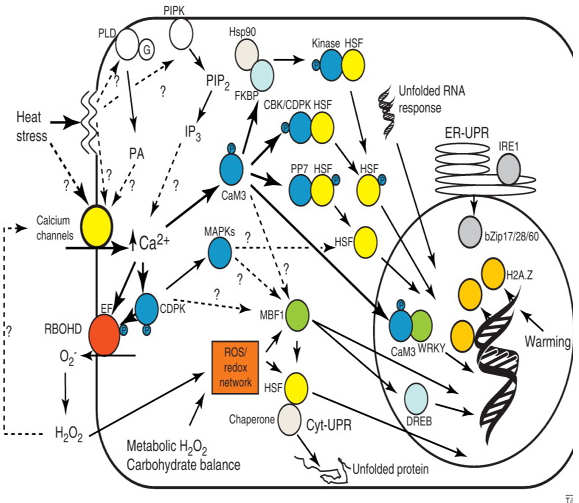
See Mittler et al., 2012
The lettuce gene NCED4 is responsible for germination of seeds at high temperatures.
See Argyris et al., 2010.
The heat shock (HS) process is induced in stages.
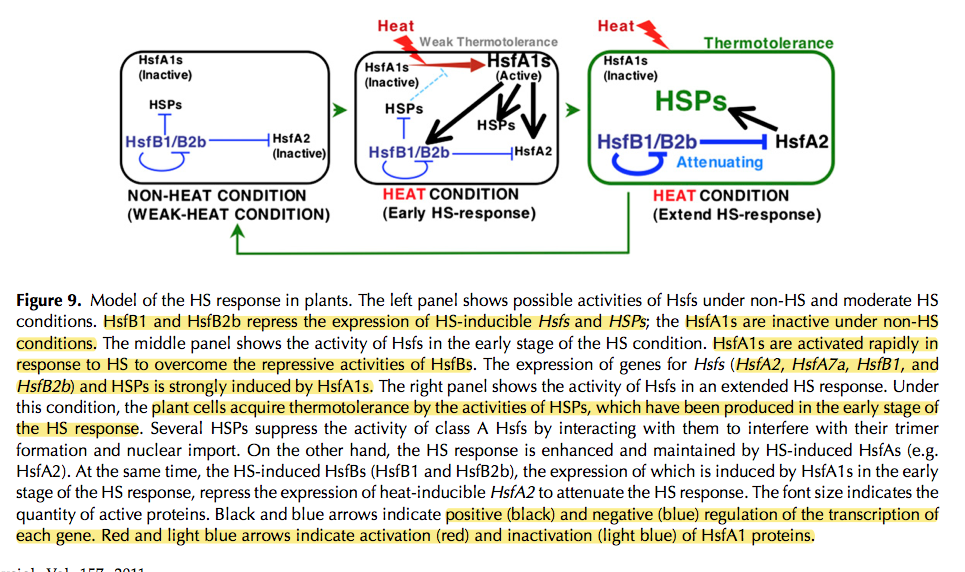
Heat Shock Transcription Factors (HsFs) are subdivided into three classes called A, B and C. (Lin et al., 2011)
25 maize HsFs have been identified (see table from Lin et al.)
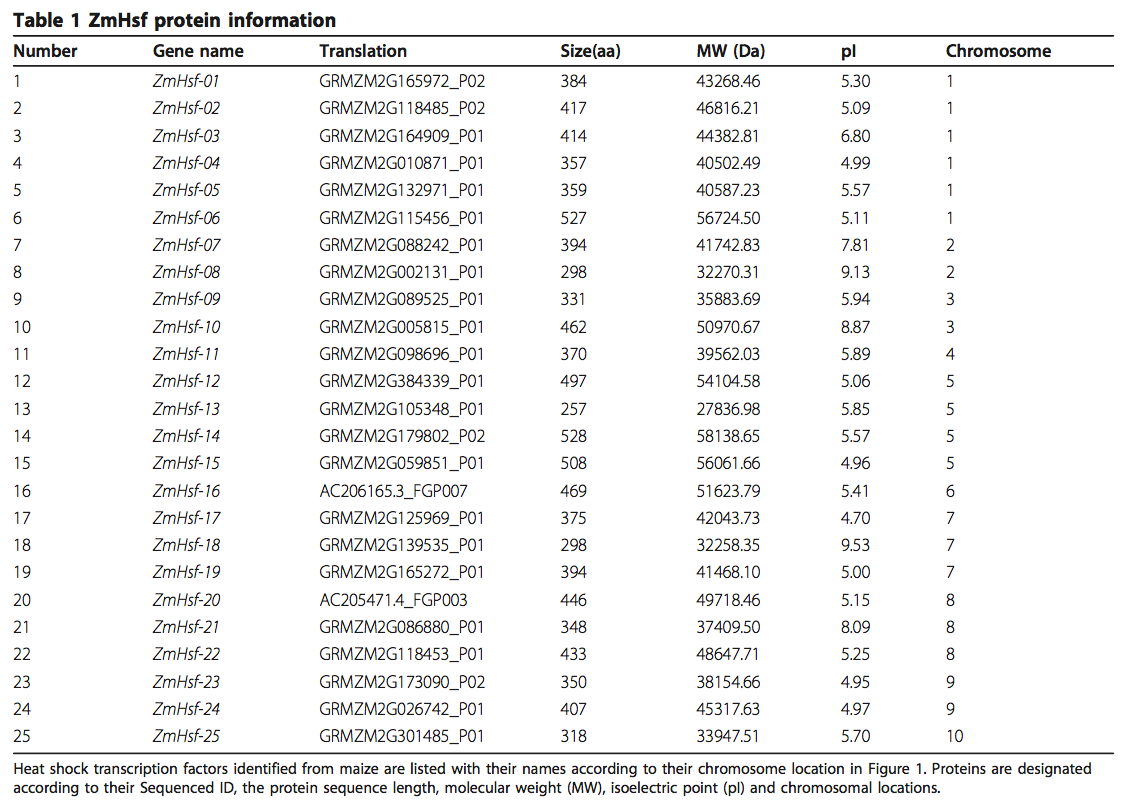
The DNS Binding Domain (DBD) from HsFs was used as a query to find them in maize. zmHsFs were aligned to show conservation and divergence. (Lin et al., 2011).
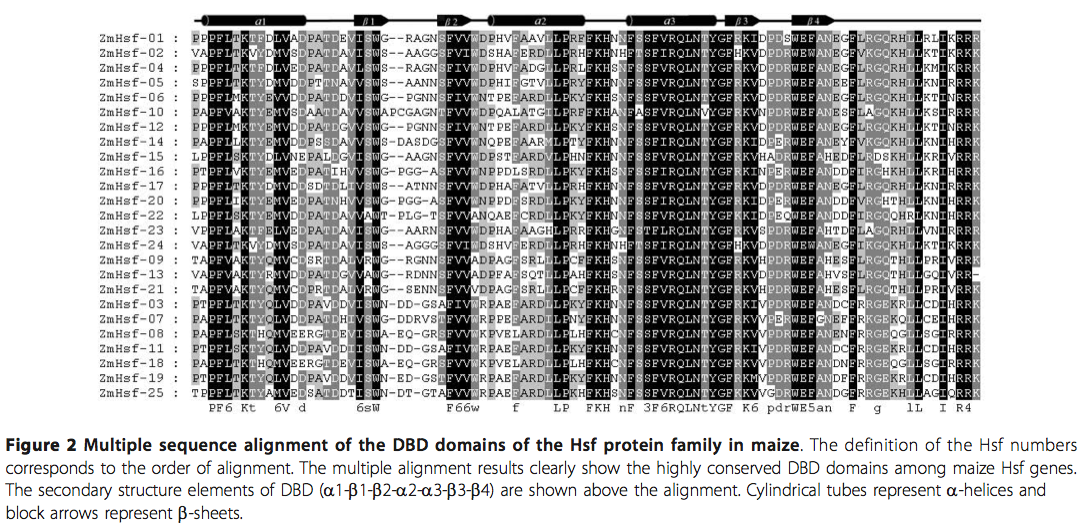
In Arabidopsis, ABSCISIC ACID–INSENSITIVE3 (ABI3) is a transcription factor induced in seeds that induces the transcription of seed-specific HsFs (Kotak et al., 2007). I should look for the blueberry ortholog.
In Monke et al., 2012, they found transcription factors (LEC1, PIL5 and AGL15) that turn on the production of ABI3. You can see what activates ABI3 and what ABI3 activates in the figure below (Monke et al., 2012).
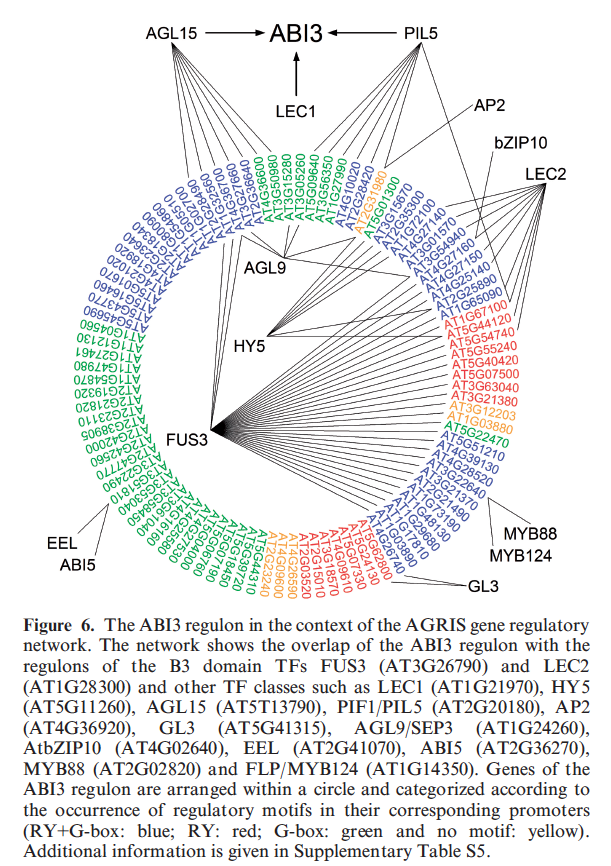
Larkindale et al. (2005) found several genes that are involved in thermotolerance.
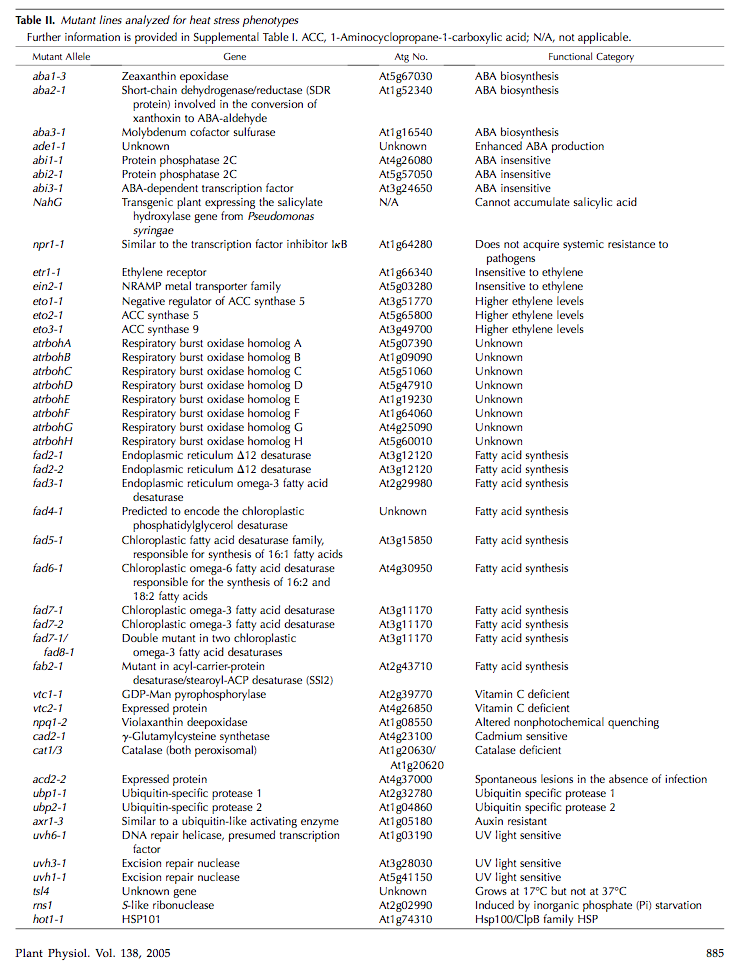
http://www.ncbi.nlm.nih.gov/pubmed/22516818
HsfA 1-independent acquired thermotolerance

From Liu and Charng, 2012
The role of nitric oxide in heat-stress:
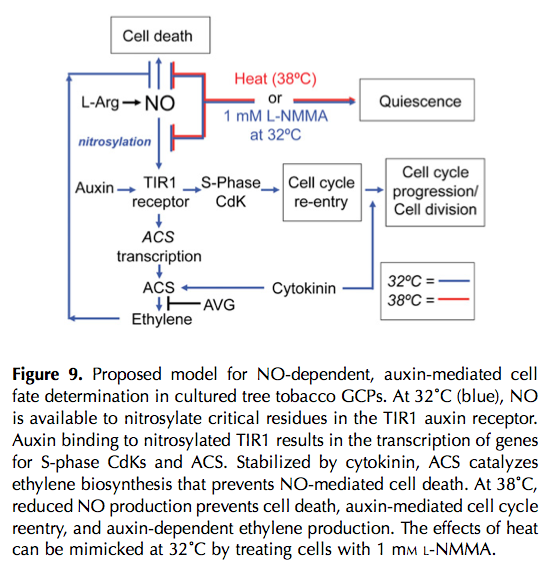
From Beard et al., 2012